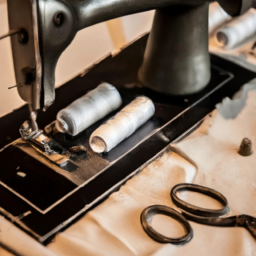
History of Sewing in India
Sewing, an art of joining fabrics together using a needle and thread, has a long and fascinating history in India. Dating back thousands of years, the rich cultural heritage of India is deeply intertwined with the art of sewing and embroidery.
In ancient times, sewing was primarily done by hand, with women diligently stitching garments for their families and loved ones. The skill of sewing was passed down from generation to generation, creating a strong tradition of intricate needlework in Indian homes.
Embroidery, an embellishment technique that involves decorating fabrics with various stitches and patterns, has been a prominent aspect of Indian sewing throughout history. Each region in India boasts its unique style of embroidery, reflecting the diversity and cultural richness of the country. From the delicate and intricate Kantha of Bengal to the vibrant and colorful Phulkari of Punjab, Indian embroidery showcases the artistry of skilled craftsmen.
Historically, sewing in India was not only limited to garments but also extended to textiles used for home decor. Indian homes were often adorned with beautiful embroidered tapestries, bedspreads, and pillowcases. These ornate pieces not only added a touch of elegance to the interiors but also served as a means of storytelling, depicting mythological tales and cultural motifs.
With the arrival of the Mughals in India, sewing techniques underwent further refinement and flourished under their influence. Intricate art forms like zardozi, a type of metal embroidery using gold and silver threads, gained popularity and became a symbol of luxury. The Mughals also introduced new fabrics, such as velvet, brocade, and muslin, which were meticulously stitched into opulent garments for the royal court.
The advent of the industrial revolution in the late 19th century brought mechanization to the art of sewing in India. Sewing machines rapidly replaced hand-sewing techniques, revolutionizing the garment industry. This shift led to increased efficiency, mass production, and the ability to create intricate designs more quickly.
Today, sewing in India has seen a resurgence as designers and artisans seek to revive traditional techniques. The rise of sustainable fashion and the appreciation for handmade products has reinvigorated the art of sewing, with craftspeople incorporating ancient embroidery techniques into contemporary designs. Indian designers are now celebrated globally for their intricate textile work, breathing new life into this timeless craft.
In conclusion, the history of sewing in India is a testament to the country’s rich cultural heritage and artistic traditions. From hand-stitching garments to elaborate embroidery, the art of sewing has evolved over centuries, leaving an indelible mark on Indian history and culture. As we embrace the future, it is crucial to cherish and preserve this ancient craft, ensuring that the legacy of Indian sewing continues to thrive for generations to come.




